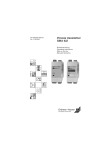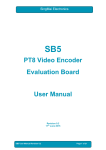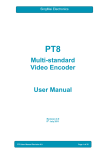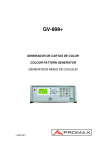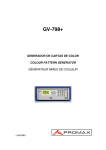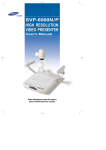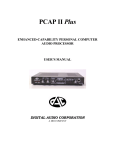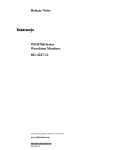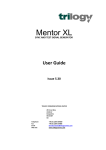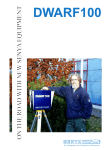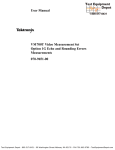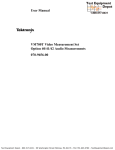Download SM01 Standard Definition Video Encoder and Pattern Generator
Transcript
SM01 Standard Definition Video Encoder and Pattern Generator User Manual Revision 0.5 th 27 February 2015 1 Contents Contents ........................................................................................................ 2 Tables ........................................................................................................... 3 Figures .......................................................................................................... 3 1. Introduction ............................................................................................... 5 2. Connecting up the SM01 .......................................................................... 7 3. Quick Start Guide .................................................................................... 10 Switch On and Control ............................................................................ 10 Menu control ........................................................................................... 12 4. SM01 Patterns ........................................................................................ 19 75% Colour bars ..................................................................................... 19 100% Colour bars ................................................................................... 20 SMPTE Colour bars (NTSC only) ........................................................... 21 75% Bars + Red (PAL only).................................................................... 23 Ramp ...................................................................................................... 23 10-step staircase (960H only) ................................................................. 24 5-step staircase ...................................................................................... 25 CCIR330 (PAL only) ............................................................................... 25 N7CMPF (NTC-7 Composite, NTSC only) ............................................. 26 CCIR17 (PAL only) ................................................................................. 27 2T20TPB (960H only) ............................................................................. 28 Black ....................................................................................................... 28 White....................................................................................................... 28 Pedestal (525 line), 50% F/F (625 line) .................................................. 28 Bounce .................................................................................................... 29 Sweep ..................................................................................................... 29 FCCMB (NTSC only) .............................................................................. 30 CCIR18 (PAL only) ................................................................................. 30 Multi (960H only)..................................................................................... 31 N7CMBF (NTC-7 Combination – NTSC only) ........................................ 32 CCIR331 (PAL only) ............................................................................... 32 Gamut ..................................................................................................... 33 Pathological (NTSC/PAL only) ............................................................... 34 Bowtie (960H only) ................................................................................. 34 Matrix ...................................................................................................... 35 Zone Plate .............................................................................................. 36 H sweep/V sweep/Zone Pl (NTSC1280/PAL1280 only) ........................ 39 H Freq (NTSC1280/PAL1280 only) ........................................................ 40 5. SM01 Noise generator ............................................................................ 41 Appendix A: SM01 specification ................................................................. 42 2 Appendix B: Power supply specification ..................................................... 60 Tables Table 1 CVBS output specification. ...............................................................8 Table 2 Analogue Component output Specifications ....................................9 Table 3 SDI Output Specifications .................................................................9 Table 4 SDI Input specification. .....................................................................9 Table 5 SM01 Patterns. .............................................................................. 15 Table 6 75% colour bars composite output levels. ..................................... 20 Table 7 100% colour bars composite levels. .............................................. 21 Table 8 NTSC/PAL timing specifications. ................................................... 43 Figures Figure 1 SM01 rear panel. .............................................................................7 Figure 2 SM01 AC-DC converter ...................................................................8 Figure 3 SM01 Front panel. ........................................................................ 10 Figure 4 SM01 Menu structure. .................................................................. 12 Figure 5 75% Component colour bar waveform. ........................................ 19 Figure 6 100% Colour bar waveform. ......................................................... 20 Figure 7 SMPTE Colour Bar component waveform ................................... 22 Figure 8 SMPTE Reverse colour bars waveform ....................................... 22 Figure 9 SMPTE Pluge waveform .............................................................. 23 Figure 10 Limit ramp waveform. ................................................................. 24 Figure 11 960H 10-step waveform. ............................................................ 24 Figure 12 5-step staircase waveform. ........................................................ 25 Figure 13 CCIR330 waveform. ................................................................... 26 Figure 14 N7CMPF (NTC-7) Component Waveform ................................. 27 Figure 15 CCIR17 Waveform ..................................................................... 28 Figure 16 Sweep Waveform ....................................................................... 29 Figure 17 FCCMB Waveform ..................................................................... 30 Figure 18 CCIR18 Waveform ..................................................................... 31 Figure 19 N7CMBF Component Waveform................................................ 32 Figure 20 CCIR331 Waveform ................................................................... 33 Figure 21 Gamut Waveform ....................................................................... 33 Figure 22 Bowtie waveform. ....................................................................... 34 Figure 23 Bowtie markers waveform. ......................................................... 35 Figure 24 Matrix test signal......................................................................... 36 Figure 25 The circular zone plate. .............................................................. 37 Figure 26 The zone plate horizontal frequency response. ......................... 38 3 Figure 27 Left side: The zone plate shows flickering colours at the subcarrier frequency as the line comb fails on the zone plate image. ........ 39 Figure 28 Hum generator. ........................................................................... 41 Figure 29 PAL horizontal timing (composite output). .................................. 43 Figure 30 PAL vertical timing (composite output). ...................................... 44 Figure 31 NTSC Horizontal timing (composite output). .............................. 45 Figure 32 NTSC Vertical timing (composite output). .................................. 46 Figure 33 NTSC 75% colour bar composite output. ................................... 47 Figure 34 NTSC 75% colour bars vectors .................................................. 48 Figure 35 PAL 75% colour bars (composite output) ................................... 49 Figure 36 PAL 75% colour bars vectors ..................................................... 50 Figure 37 NTSC K_Factor measurement. ................................................. 51 Figure 38 NTSC NTC-7 Luma/Chroma delay/gain measurement .............. 52 Figure 39 NTSC Differential gain/phase measurement. ............................. 53 Figure 40 NTSC noise measurement (Pedestal waveform). ...................... 54 Figure 41 Luma frequency response (CCIR18 test signal). ....................... 55 Figure 42 Chrominance non-linearity (using N7C-Combination test signal). .................................................................................................................... 56 Figure 43 SDI output 525 line format measurement ................................... 57 Figure 44 SDI output 625 line format measurement ................................... 57 Figure 45 SDI output 625 line eye pattern .................................................. 58 Figure 46 SDI output 625 line jitter measurement ...................................... 59 Figure 47 AC-DC converter specification: Page 1 ...................................... 60 Figure 48 AC-DC converter specification: Page 2 ...................................... 61 Figure 49 AC-DC converter specification: Page 3 ...................................... 62 4 1. Introduction SM01 is a video encoder and pattern generator supporting standard definition video standards. As a video pattern generator, SM01 can generate 15 NTSC, 15 PAL and 15 960H line based patterns, a zone plate generator, and a programmable 12MHz maximum horizontal frequency sweep. These are output as simultaneous SDI (SMPTE-259M – NTSC/PAL only), YPbPr component, NTSC-M/J/443 or PAL-M/60 (for 525 line standards) or PAL-BG/I or PAL-N (for 625 line standards) or 960H (NTSC or PAL) or 1280H (NTSC or PAL – zone plate, vertical and horizontal sweep only) formats. Patterns available include: 75%/100%/SMPTE/Bars+Red colour bars Black/White/50% grey flat fields 2T, 20T and Pulse bar CCIR17/18/330 and 331 FCC Comp and FCC MB N7C MBF and N7C MPF Ramp Multi-burst Horizontal (up to 12MHz) and Vertical Sweeps 5/10 step linearity Pathological (SDI test) Gamut Bowtie Circular Zone Plate In addition programmable amplitude noise may be added to the CVBS pattern output. Noise can be 50Hz or 60Hz hum and/or white noise. As a video encoder SM01 accepts 525 or 625 line SMPTE-259M inputs which it encodes to simultaneous SDI (SMPTE-259M), YPbPr component and NTSC-M/J/443, PAL-M/PAL-60 (525 line standards) or PAL-BG/I, PALN (for 625 line standards). Again noise may be added to the CVBS output. 5 Controls provided include: CVBS amplitude CVBS Luma amplitude CVBS Chroma amplitude CVBS Burst amplitude CVBS Sync amplitude CVBS Black level NTSC Hue (Chroma phase) CVBS subcarrier frequency YPbPr Luma amplitude YPbPr Chroma amplitude YPbPr Sync amplitude YPbPr Black level SM01 is powered by a universal input power supply and controlled with a simple and intuitive selection menu. 6 2. Connecting up the SM01 All connections to the SM01 are made via the rear panel: see Figure 1. Figure 1 SM01 rear panel. The AC-DC converter connects to the left hand jack. The SM01 input is protected against reverse polarity. The converter supplied with the SM01 is a model MW173KB manufactured by SL Power Electronics Corp. and provides 9VDC at 3A and accepts AC inputs from 100-240VAC. Connect the supplied power cord to the AC-DC converter and output DC of the converter to the 9VDC Power In input of the SM01. 7 Figure 2 SM01 AC-DC converter A full specification for the supplied AC-DC converter may be found in Appendix B. The SM01 provides both analogue and digital component outputs for connecting to the equipment under test. The CVBS (NTSC/PAL) output is connected to the BNC, ‘CVBS Out’. The specification for the output is shown in Table 1. The composite output specification is detailed in Appendix A. Parameter Connector Type Output impedance Output return loss CVBS output level Specification BNC 75Ω >30dB 1.0V pk.pk Comments 0-5MHz Nominal peak Y to sync tip for 100% colour bars input Table 1 CVBS output specification. 8 The analogue component outputs are connected to the BNCs, ‘Y Out’, ‘Pb Out’ and ‘Pr Out’. The specification for the outputs is shown in Table 2. The component output specification is detailed in Appendix A. Parameter Specification Connector Type Output impedance Output return loss Y output level BNC 75Ω >30dB 1.0V pk.pk Cb/Cr output levels 700mV pk-pk Comments 0-5MHz Nominal 100% colour bars input Nominal 100% colour bars input Table 2 Analogue Component output Specifications The serial digital interface (SDI) output is connected to the ‘SDI Out’ BNC and its specifications are shown in Table 3. The SDI output conforms to the SMPTE-259M specification. The SDI output specification is detailed in Appendix A. Parameter Connector Type Output impedance Output return loss Output level Jitter Specification BNC 75Ω >15dB 800mV pk-pk ± 10% <0.2UI Comments Fixed termination 50Hz-270MHz Table 3 SDI Output Specifications The serial digital interface (SDI) input (only used in encoder mode) is connected to the ‘SDI In’ BNC and its specifications are shown in Table 4. The SDI input conforms to the SMPTE-259M specification. Parameter Connector Type Input impedance Input return loss Input level Specification BNC 75Ω >15dB 800mV pk-pk Comments Fixed termination 50Hz-270MHz Nominal Table 4 SDI Input specification. 9 3. Quick Start Guide Switch On and Control Connect the AC-DC converter 9VDC cable into the rear panel power in socket. Connect the AC supply to a local AC supply between 110-240VAC. The Standby LED should light. Push the Adjust control and the unit will switch on and the welcome message will be displayed (SingMai SM01). To switch off the SM01 push the Adjust control again. The front panel of the SM01 is shown in Figure 3. Figure 3 SM01 Front panel. There are just two controls for the SM01. The right hand control (Adjust) switches the unit between On and Standby by pushing it whilst also adjusting the value of parameters by rotating the knob left or right. The central switch (Select) selects the chosen menu parameter and switches preset parameters between, for example, on and off. After the welcome message (‘SingMai, SM01’) is displayed for a few seconds the LCD display will show the available top level menus. A left hand arrow indicates which menu is ‘active’. Rotating the Adjust control will show all the available menus; after the last of the menus an up arrow is shown. To select a menu ensure the left arrow is by the side of the required top level menu and press the Select button. Those menu options will then be displayed. 10 To change a parameter within the lower menu choices choose the required item by aligning the left arrow with it and press the Select button. The parameter will either toggle between the available options (e.g. On or Off) or will show a menu bar where to can select more options via the Adjust control. Once you have chosen the setting you require press the Select button to return to the menu choices. The Adjust control is also used to set the parameter values. Once set the required value, press the Select button to retain that value and return to the menu. To return to the top level menu scroll down the menu choices using the Adjust control; the last one before the up arrow will show Exit. Select this by pressing the Select button and you will return to the top level menus. 11 Menu control The complete menu structure is shown in Figure 4. Figure 4 SM01 Menu structure. 12 The following is a brief description of the menu functions. SDI in: Pattern (Encoder) Each button press toggles between the internal patterns (Pattern – default value) and the serial digital (SDI) input (Encoder). (Note: the SDI input is not operative for the 960H or 1280H standards.) Exit Returns to the top level menus. Stand’d (Standard): In Encoder mode the SDI input standard must match the output standard selection. (i.e. if the SDI input is 625 line standard, selecting NTSC-M/J/443/PAL-60 or PAL-M will result in corrupted outputs). NTSC-M Forces NTSC-M output standard for the composite output and 525 line standard for the YPbPr and SDI outputs. (Default value) NTSC-J Forces NTSC-J output standard for the composite output and 525 line standard for the YPbPr and SDI outputs. (NTSC-J is the Japanese version of NTSC, which has no setup and different output levels to NTSC-M). NTSC443 Forces NTSC443 output standard for the composite output and 525 line standard for the YPbPr and SDI outputs. (NTSC-443 is a playback ‘standard’ which has NTSC timing characteristics with a 4.433MHz PAL subcarrier frequency). PAL-BG Forces PAL-BG output standard for the composite output and 625 line standard for the YPbPr and SDI outputs. PAL-I Forces PAL-M output standard for the composite output and 525 line standard for the YPbPr and SDI outputs. 13 (Note the difference between PAL-BG and PAL-I is only the front porch value). PAL-N Forces PAL-N output standard for the composite output and 625 line standard for the YPbPr and SDI outputs. PAL-60 Forces PAL-60 output standard for the composite output and 525 line standard for the YPbPr and SDI outputs. (PAL-60 has NTSC timing characteristics but with a PAL 4.43 subcarrier frequency and PAL phase alternate line switching). NTSC960 Forces NTSC-M output standard for the composite output and 525 line standard for the YPbPr outputs. (Note the 960H sampling frequency is 36MHz). PAL-960 Forces PAL-BG output standard for the composite output and 625 line standard for the YPbPr outputs. (Note the 960H sampling frequency is 36MHz). NTSC128 Forces NTSC-M output standard for the composite output and 525 line standard for the YPbPr outputs. (Note the 1280H sampling frequency is 54MHz). PAL1280 Forces PAL-BG output standard for the composite output and 625 line standard for the YPbPr outputs. (Note the 1280H sampling frequency is 54MHz). Exit Returns to the top level menus. The specifications for the standards are shown in Appendix A. 14 Pattern: Selects the output pattern when in ‘Pattern’ mode. (In ‘Encoder’ mode the pattern menu cannot be selected.) The patterns available depend on the standard selected. Table 5 lists the patterns available for each standard. A full description of the patterns can be found in Chapter 4. Table 5 SM01 Patterns. 15 P’meter (Parameter): Note that some combinations of the parameter settings can give invalid outputs and may result in clipping of the signal. CVBS Adjusts the output amplitude of the composite video output. Default value is 100% (gain of 1). Range is 0-130%. CVBS-Y Adjusts the output amplitude of the luma component of the composite video output. Default value is 100% (gain of 1). Range is 0-130%. CVBS-C Adjusts the output amplitude of the chroma component of the composite video output. Default value is 100% (gain of 1). Range 0-130%. Burst Adjusts the output amplitude of the colour burst of the composite video output. Default value is 100% (gain of 1). Range 0-130%. CVBS-S Adjusts the output amplitude of the synchronizing signals of the composite video output. Default value is 100% (gain of 1). Range is 0-130%. CVBS-B Adjusts the output black level of the composite video output. Default value is pedestal value for NTSC-M or 0mV for other standards). Default value is 0 (offset of 0mV). Range is ±100. NTSCHue Adjusts the phase of the chroma component (hue) for composite video output (NTSC-M/-J/-443 only). Default value is 0deg. Range is ±180deg. FSc Adjusts the frequency of the subcarrier for the composite video output. Default value is 0Hz. Range is ±400Hz. YPbPr-Y Adjusts the output amplitude of the luma (Y channel) of the component YPbPr analogue video output. Default value is 100% (gain of 1). Range is 0-130%. 16 YPbPr-C Adjusts the output amplitude of the chroma (Pb/Pr) of the component YPbPr analogue video output. Default value is 100% (gain of 1). Range is 0-130%. YPbPr-S Adjusts the output amplitude of the synchronizing signals of the component Y analogue video output. Default value is 100% (gain of 1). Range is 0130%. YPbPr-B Adjusts the black level value of the luma component of the component YPbPr analogue video output. Default value is 100 (offset of 0mV). Range is ±100. Exit Returns to the top level menus. Noise: Y Noise Selects a sub menu which allows control of the amplitude of white noise injected into the Y output channel of the CVBS analogue output only. The range of the control is from 0 (off – default value) to 100 (maximum noise). A fuller description of the noise generator may be found in Chapter 5. Video (V+Sync) The injected noise (white noise) is limited to the active video portion of the analogue output waveform (Video – default value) or the entire waveform (V+Sync). Hum Selects a sub menu which allows control of the amplitude of hum injected into the CVBS analogue output. The range of the control is from 0 (off – default value) to 100 (maximum hum). A fuller description of the noise generator may be found in Chapter 5. Hum60Hz (Hum50Hz) Selects frequency of the hum (50Hz or 60Hz). Exit Returns to the top level menus. 17 Setup: B’light Controls the brightness of the front panel LCD backlight. Default value is ‘4’. VITSOn (VITSOff) Inserts the CCIR17, CCIR18, CCIR330 and CCIR331 test patterns onto lines 17, 18, 330 and 331 respectively of the PAL output standard if enabled (VITSOn) or the N7CMBF and N7CMPF onto line 17 of fields 1 and 2 respectively of the NTSC standard. Default value is VITS on. C’maOn (C’maOff) Turns off the chroma component of the CVBS output and sets the Pb/Pr outputs of the analogue component output to blanking level if set (C’maOff). Default value is chroma on (C’maOn). Exit Returns to the top level menus. 18 4. SM01 Patterns Below is a detailed description of each of the SM01 patterns. (Note: The NTSC/PAL 1280H standards only provide a set of programmable frequency sweeps that allow the performance of this standard’s extended luma bandwidth to be measured. The description of these patterns are at the end of this chapter.) 75% Colour bars 75% colour bars are used for measuring insertion gain, chroma level and chroma gain and for monitor alignment. The SM01 generates full frame 75% saturated colour bars with a 100% white bar reference and 7.5 IRE setup (for the NTSC-M/PAL-M composite output only). The colour bar sequence is white, yellow, cyan, green, magenta, red, blue and black. 525 line 75% Colour Bars Cb/Cr Pixel No. 0 50 100 150 1000 200 250 300 350 400 900 900 800 800 700 10 bit value 700 600 600 500 500 Y Value (Dec) Cb Value (Dec) 400 400 Cr Value (Dec) 300 300 200 200 100 100 0 0 100 200 300 400 500 600 700 0 800 Y Pixel No. Figure 5 75% Component colour bar waveform. The output levels for the composite bar waveform are shown below. mV White Yellow Cyan Green NTSC-M(J) / PAL-M 100/7.5/75/7.5 Luminance Chrominance 714.29(714.29) 0.00(0.00) 492.62(474.64) 443.34(479.29) 400.94(375.54) 626.69(677.50) 344.45(314.46) 585.18(632.63) 19 PAL / PAL-N 100/0/75/0 Luminance Chrominance 700.00 0.00 465.15 470.50 368.03 663.81 308.18 620.09 mV NTSC-M(J) / PAL-M 100/7.5/75/7.5 Luminance Chrominance 258.22(221.25) 585.18(632.63) 201.73(160.18) 626.69(677.50) 110.06(61.07) 443.34(479.29) 53.57(0.00) 0.00(0.00) Magenta Red Blue Black (Setup) PAL / PAL-N 100/0/75/0 Luminance Chrominance 216.83 620.09 156.98 663.81 59.85 470.50 0.00 0.00 Table 6 75% colour bars composite output levels. 100% Colour bars 100% colour bars are used for measuring insertion gain, chroma level and chroma gain and for monitor alignment. The SM01 generates full frame 100% saturated colour bars with a 100% white bar reference and 7.5 IRE setup (for the composite output only). The colour bar sequence is white, yellow, cyan, green, magenta, red, blue and black. Note that 100% NTSC colour bars will cause clipping in the transmitter and they are therefore only used within a studio ‘closed system’. 525 line 100% Colour bars Cb/Cr Pixel No. 0 50 100 150 200 250 300 350 1000 400 1200 900 1000 800 10 bit value 700 800 600 Y Value (Dec) 500 600 Cb Value (Dec) Cr Value (Dec) 400 400 300 200 200 100 0 0 100 200 300 400 500 600 700 0 800 Y Pixel No. Figure 6 100% Colour bar waveform. The output levels for the composite bar waveform are shown below. 20 mV White Yellow Cyan Green Magenta Red Blue Black (Setup) NTSC-M(J) / PAL-M 100/7.5/100/7.5 Luminance Chrominance 714.29(714.29) 0.00(0.00) 638.96(632.86) 591.12(639.05) 516.73(500.71) 835.58(903.33) 441.41(419.28) 780.24(843.50) 326.44(295.00) 780.24(843.50) 251.13(213.57) 835.58(903.33) 128.89(81.43) 591.12(639.05) 53.57(0.00) 0.00(0.00) PAL / PAL-N 100/0/100/0 Luminance Chrominance 700.00 0.00 620.20 627.33 490.70 885.08 410.90 826.79 289.10 826.79 209.30 885.08 79.80 627.33 0.00 0.00 Table 7 100% colour bars composite levels. SMPTE Colour bars (NTSC only) 67% of the SMPTE colour bar waveform comprises 75% colour bars; white, yellow, cyan, green, magenta, red and blue. Below this and comprising 8% of the frame, is a sequence of blue, black, magenta, black, cyan, black, white bars. The function of these bars is to set monitor chroma gain and phase – the red and green monitor outputs are switched off and the monitor hue (chroma phase) is adjusted to equalize the cyan/magneta and magenta/cyan vertical transitions. The chroma saturation is then used to equalize the transition between white/blue vertical transition. The bottom 25% of the SMPTE pattern is, from left to right, -I, white, Q, black and pluge. The pluge (±4 IRE bars) is used to set up the monitor black level; the whiter than black bar should be visible, the blacker than black bar should not. The –I and Q elements of the SMPTE pattern are longer used. 21 525 Line SMPTE Colour Bars Cb/Cr Pixel No. 0 50 100 150 800 200 250 300 350 400 900 700 800 700 10 bit value 600 600 500 500 400 Y Value (Dec) Cb Value (Dec) 400 300 Cr Value (Dec) 300 200 200 100 100 0 0 100 200 300 400 500 600 700 0 800 Y Pixel No. Figure 7 SMPTE Colour Bar component waveform 525 Line Reverse Colour Bars Cb/Cr Pixel No. 0 50 100 150 800 200 250 300 350 400 900 700 800 700 10 bit value 600 600 500 500 400 Y Value (Dec) Cb Value (Dec) 400 300 300 200 200 100 100 0 0 100 200 300 400 500 600 700 0 800 Y Pixel No. Figure 8 SMPTE Reverse colour bars waveform 22 Cr Value (Dec) 525 Line SMPTE Pluge Cb/Cr Pixel No. 0 50 100 150 1000 200 250 300 350 400 800 900 700 800 600 10 bit value 700 500 600 Y Value (Dec) 500 400 400 300 Cb Value (Dec) Cr Value (Dec) 300 200 200 100 100 0 0 100 200 300 400 500 600 700 0 800 Y Pixel No. Figure 9 SMPTE Pluge waveform 75% Bars + Red (PAL only) The top half of this pattern is 75% colour bars, as described above. The bottom half is a 75% saturation red field. Ramp This waveform is a linear modulated ramp and may be used to measure linearity as well as differential gain and phase. 23 525 Line Limit ramp Cb/Cr Pixel No. 10 bit value 0 50 100 150 1200 200 250 300 350 400 1200 1000 1000 800 800 600 600 400 400 200 200 Y Value (Dec) Cb Value (Dec) Cr Value (Dec) 0 0 100 200 300 400 500 600 700 0 800 Y Pixel No. Figure 10 Limit ramp waveform. 10-step staircase (960H only) This waveform is ten, equal amplitude, steps of luma and chroma and may be used to measure linearity as well as differential gain and phase. Figure 11 960H 10-step waveform. 24 5-step staircase This waveform is five, equal amplitude, steps of luma and chroma and may be used to measure linearity as well as differential gain and phase. Figure 12 5-step staircase waveform. CCIR330 (PAL only) This waveform is one of the four PAL vertical interval test signals (VITS) and comprises a pulse and bar and modulated five-step staircase. It is used for the measurement of differential gain and phase. 25 625 Line CCIR330 Cb/Cr Pixel No. 0 50 100 150 200 250 300 350 1000 900 400 700 600 800 500 10 bit value 700 600 400 500 Y Value (Dec) Cb Value (Dec) 300 400 300 Cr Value (Dec) 200 200 100 100 0 0 100 200 300 400 500 600 700 0 800 Y Pixel No. Figure 13 CCIR330 waveform. The CCIR330 signal is inserted on line 330 of the CVBS output by enabling ‘VITSOn’ in the Setup menu, (default is on). N7CMPF (NTC-7 Composite, NTSC only) The NTC-7 pattern consists of a 100% white bar, 2T pulse, 12.5T chrominance pulse and a 5-step modulated staircase. The 100% white bar can be used for gain calibrations and coupling distortion measurements (flat top to the bar). The 2T pulse is used for measuring distortion in the system group delay (the delay vs. frequency response of system). The 12.5T chroma pulse may be used for measuring relative luma to chroma delay and gain and the 5-step staircase is used to measure differential gain (the difference in amplitude between each step in the staircase and the colour burst) and differential phase (the difference in phase between each step in the staircase and the colour burst). N7CMPF is one of the NTSC test signals and is inserted on line 17, field 1 of the CVBS output by enabling ‘VITSOn’ in the Setup menu, (default is on). Measurements using the NTC-7 composite signal can be seen in Appendix A. 26 525 Line N7CMPF Cb/Cr Pixel No. 0 50 100 150 1000 200 250 300 350 400 900 900 800 800 700 10 bit value 700 600 600 500 500 Y Value (Dec) Cb Value (Dec) 400 400 Cr Value (Dec) 300 300 200 200 100 100 0 0 100 200 300 400 500 600 700 0 800 Y Pixel No. Figure 14 N7CMPF (NTC-7) Component Waveform CCIR17 (PAL only) The CCIR17 pattern consists of a 100% reference luminance bar followed by 2T and 20T pulses and a 5 step luminance staircase. The pattern may be used for the measurement of K-factor, luma/chroma gain/delay and luminance linearity. The CCIR17 signal is also inserted on line 17 of the output signal by enabling ‘VITSOn’ in the Setup menu, (default is on). 27 625 Line CCIR17 Cb/Cr Pixel No. 0 50 100 150 1000 200 250 300 350 400 900 900 800 800 700 10 bit value 700 600 600 500 500 Y Value (Dec) Cb Value (Dec) 400 400 Cr Value (Dec) 300 300 200 200 100 100 0 0 100 200 300 400 500 600 700 0 800 Y Pixel No. Figure 15 CCIR17 Waveform 2T20TPB (960H only) The 2T20TPB signal is a pulse, bar and two pulses, 2T and 20T wide. It allows the measurement of K-factor and luma/chroma gain and delay. A separate signal to the CCIR17 and NTC-7 waveforms is created because 960H has a wider bandwidth (e.g. 18MHz luma sampling, compared to 13.5MHz luma sampling for NTSC/PAL). Black Black is a full frame 0 IRE (NTSC-M) or 0mV (PAL) video signal that may be used for noise measurements. White White is a full frame 100 IRE (NTSC-M) or 700mV (PAL) video signal that may be used for noise measurements or for finding AC coupling or clamping issues. Pedestal (525 line), 50% F/F (625 line) Pedestal is a full frame 50 IRE (NTSC) or 350mV (50%, PAL) video signal that may be used for noise measurements. The noise measurement of the 28 SM01 using this signal and measured with the Tektronix VM700 is shown in Appendix A. Bounce The bounce test signal switches between black and white test signals at field frequency (50 or 60Hz). It is used to measure field time distortion or detect clamping issues. Sweep Sweep is a swept frequency waveform used for testing the system frequency response. For PAL/NTSC the frequency range is 0.25MHz to 5.75MHz for luma and 0.125MHz to 2.75MHz for chroma. For 960H the frequency range is 0.25MHz to 7.75MHz for luma and 0.125MHz to 2.75MHz for chroma. 525 Line Sweep Cb/Cr Pixel No. 10 bit value 0 50 100 150 900 200 250 300 350 400 900 800 800 700 700 600 600 500 500 400 400 300 300 200 200 100 100 Y Value (Dec) Cb Value (Dec) 0 0 100 200 300 400 500 600 700 Y Pixel No. Figure 16 Sweep Waveform 29 0 800 Cr Value (Dec) FCCMB (NTSC only) The FCCMB test signal is a pulse reference followed by six frequency packets at 0.5MHz, 1.25MHz, 2.0MHz, 3.0MHz, 3.579545MHz and 4.1MHz. 525 Line FCCMB Cb/Cr Pixel No. 0 50 100 150 200 250 300 350 1000 400 600 900 500 800 10 bit value 700 400 600 Y Value (Dec) 500 300 Cb Value (Dec) Cr Value (Dec) 400 200 300 200 100 100 0 0 100 200 300 400 500 600 700 0 800 Y Pixel No. Figure 17 FCCMB Waveform CCIR18 (PAL only) The CCIR18 pattern is a standard VITS, (Vertical Interval Test Signal), pattern consisting of a luminance reference bar followed by 6 multi-burst packets at 0.5MHz, 1.0MHz, 2.0MHz, 3.0MHz, 4.8MHz and 5.8MHz of 60% amplitude on a 50% pedestal. The CCIR18 signal is inserted on line 18 of the output signal by enabling ‘VITSOn’ in the Setup menu, (default is on). The frequency response of the SM01 measured with the CCIR18 test signal is shown in Appendix A. 30 625 Line CCIR18 Cb/Cr Pixel No. 0 50 100 150 200 250 300 350 900 400 600 800 500 700 10 bit value 600 400 Y Value (Dec) 500 300 400 300 Cb Value (Dec) Cr Value (Dec) 200 200 100 100 0 0 100 200 300 400 500 600 700 0 800 Y Pixel No. Figure 18 CCIR18 Waveform Multi (960H only) The FCCMB test signal is a pulse reference followed by six luma frequency packets at 0.5MHz, 1.0MHz, 2.0MHz, 4.0MHz, 6.0MHz and 7.75MHz. The chroma signal comprises 5 packets at 0.5MHz, 1.0MHz, 1.5MHz, 2.0MHz and 2.75MHz. 31 N7CMBF (NTC-7 Combination – NTSC only) The NTC-7 Combination pattern consists of a white bar at 100 IRE, 6 multiburst packets of 50 IRE amplitude on a 50 IRE pedestal (at 0.5MHz, 1.0MHz, 2.0MHz, 3.0MHz, 3.58MHz and 4.2MHz) and a 20,40 and 80 IRE amplitude modulated chrominance on a 50 IRE pedestal. The latter can be used to measure chrominance linearity as shown in Appendix A. 525 Line N7CMBF Cb/Cr Pixel No. 0 50 100 150 1000 200 250 300 350 400 900 900 800 800 700 10 bit value 700 600 600 500 500 Y Value (Dec) Cb Value (Dec) 400 400 Cr Value (Dec) 300 300 200 200 100 100 0 0 100 200 300 400 500 600 700 0 800 Y Pixel No. Figure 19 N7CMBF Component Waveform CCIR331 (PAL only) The CCIR331 signal is used to measure chroma amplitude and phase errors as well as luma/chroma intermodulation. It is a vertical interval test signal (VITS) and is inserted on line 331 of the output signal by enabling ‘VITSOn’ in the Setup menu, (default is on). 32 625 Line CCIR331 Cb/Cr Pixel No. 0 50 100 150 200 250 300 350 600 400 1000 900 500 800 700 10 bit value 400 300 200 600 Y Value (Dec) 500 Cb Value (Dec) 400 Cr Value (Dec) 300 200 100 100 0 0 100 200 300 400 500 600 700 0 800 Y Pixel No. Figure 20 CCIR331 Waveform Gamut The gamut test signal is designed to detect errors in converting between different colour spaces (e.g. from Y,Cb,Cr to RGB). 525 Line Gamut Cb/Cr Pixel No. 0 50 100 150 1000 200 250 300 350 400 900 900 800 800 700 10 bit value 700 600 600 500 500 Y Value (Dec) Cb Value (Dec) 400 400 300 300 200 200 100 100 0 0 100 200 300 400 500 600 700 Y Pixel No. Figure 21 Gamut Waveform 33 0 800 Cr Value (Dec) Pathological (NTSC/PAL only) The pathological output is intended for stressing the equalizer of an SDI receiver. The pattern is in accordance with SMPTE-259M. The pattern consists of two parts, split horizontally into the top and bottom halves of a field as shown in Figure 41. The top half consists of a repetitive active line pattern of values Y=198h and C=300h. After scrambling this results in either 19 ‘ones’ followed by one ‘zero’ or 19 ‘zeros’ followed by one ‘one’. This output stresses the equalizer because of its low frequency content. The bottom half consists of a repetitive active line pattern of values Y=110h and C=200h. This results in an output with 20 ‘zeros’ followed by 20 ‘ones’. This bit pattern tests the receiver PLL because of the low transition frequency of edges in the data. Bowtie (960H only) The Bowtie waveform is used to measure component amplitude and timing errors. The waveform consists of a 500kHz sine wave on the luma channel and a 502kHz sine wave on the Pb and Pr outputs. Marker signals are provided to assist in the measurement. Figure 22 Bowtie waveform. 34 Figure 23 Bowtie markers waveform. Matrix The matrix test signal comprises five equally spaced patterns in one combination test signal that permits a single test signal analysis of a video component or system. The five signals are: 75% colour bars, 5 step modulated staircase, 2T/20T pulse and bar, luma multi-burst and modulated ramp. 35 Figure 24 Matrix test signal. Zone Plate Those involved in optics are probably very familiar with the circular zone plate. It is shown in Figure 25. 36 Figure 25 The circular zone plate. The zone plate is a two-dimensional linear frequency sweep with the highest frequencies at the edges of the image. It can be used to measure the horizontal and vertical frequency response of system. For example, in figure 26, I show a horizontal line of video and you can clearly see that the left and right edges of the waveform droop, showing some high frequency attenuation. 37 Figure 26 The zone plate horizontal frequency response. Attenuation on the left and right edges of the image show low pass filtering of the image; attenuation of the top and bottom of the image show vertical filtering, perhaps line to line averaging or issues with a scaler or deinterlacer. The zone plate is very useful for designing and testing composite analogue video decoders. Even a conventional line comb decoder will not be able to separate chominance and luminance of the same frequency because of the non-repetitive nature of the pattern (each horizontal line is different to the ones adjacent to it). This will result in cross-colour effects as shown in Figure 27. 38 Figure 27 Left side: The zone plate shows flickering colours at the subcarrier frequency as the line comb fails on the zone plate image. Although the frame comb decoder shows no artifacts when the zone plate is still, if we move the zone plate in time similar corruption of the image will occur. The moving zone plate is the test image from hell for an analogue video decoder. The position of the defect in the zone plate can tell us what the problem in the video processing can be, e.g. it can show us the frequency of an aliasing component. The zone plate’s use is not just restricted to analogue video decoding. Any video processing which manipulates the image spatially and/or temporally can be tested to breaking point with the zone plate: such processing includes video standards conversion, de-interlacing and scaling. H sweep/V sweep/Zone Pl (NTSC1280/PAL1280 only) Pressing the select button sequentially selects either a horizontal frequency sweep, a vertical frequency sweep or a circular zone plate pattern. The upper frequency of the horizontal sweep can be controlled using the ‘H Freq’ control. 39 H Freq (NTSC1280/PAL1280 only) Selects the upper range of the horizontal frequency sweep (this option cannot be selected in vertical sweep or zone plate mode). The range is 0Hz (flat field) to 12.0MHz in 0.1MHz steps. The default value is 1.0MHz. 40 5. SM01 Noise generator SM01 has two noise generators that can add noise to the CVBS output. The first of these uses a pseudo-random number generator to create white noise. A programmable amount of this noise is added to the luma component of the composite output. The noise can be added to the entire video signal (including the sync and blanking) or just to the active video (using the Video/Video+S select option). The maximum noise setting adds approximately 50dB of noise to the signal. The second noise generator is a programmable frequency (50Hz or 60Hz) hum generator. Figure 28 shows the hum generator on the CVBS output across a frame of video. Figure 28 Hum generator. 41 Appendix A: SM01 specification The SM01 CVBS specifications are shown in Table 8. Parameter Frame Rate/Field Rate Line Period Lines/Frame Line Blanking Interval Front Porch Line sync pulse width Back Porch Equalising Pulse width Broad Pulse width Rise/Fall times of sync edges Sync Pulse amplitude Luminance white bar amplitude Vertical Sync Group No. of equalizing pulses Chrominance Phase error Subcarrier Frequency Colour Frame duration Burst start Specification PAL B,G,I,N NTSC-M/J, PAL-M 25Hz/50Hz 30Hz/60Hz 64us 625 12us 63.555555us 525 10.7us 1.5us 4.7us 1.5us 4.7us 5.8us 2.35us 4.5us 2.3us 27.3us 250ns 27.0775us 250ns 300mV 40IRE 700mV 100IRE 7.5 lines 9 lines 5+5 6+6 <1deg <1.5deg 4.43361875MHz (PAL) 3.58205625MHz (PAL-N) 8 fields 3.5795455MHz (NTSC) 3.5756118MHz (PAL-M) 4 fields 5.64us 5.31us 42 Comments 1.65us for PAL-I NTSC/PAL-M rise time should be 140ns. 8 fields for PALM 5.3us for PAL-N Burst duration 2.25us 2.51us Burst Amplitude Differential Gain Differential Phase K Factor (2T) Chrominance luminance delay Signal to Noise ratio 300mV <1% <1deg <1% < +/- 5ns 40IRE <1% <1deg <1% < +/- 5ns -70dB (50% grey input) -70dB (50% grey). 2.51us for PALN Sin x/x corrected Sin x/x corrected Unweighted Table 8 NTSC/PAL timing specifications. The measured horizontal and vertical output timings for PAL and NTSC composite outputs are shown in Figures 29 to 32. Figure 29 PAL horizontal timing (composite output). 43 Figure 30 PAL vertical timing (composite output). 44 Figure 31 NTSC Horizontal timing (composite output). 45 Figure 32 NTSC Vertical timing (composite output). Figure 33, below, shows the 75% colour bar composite output of the SM01 compared with the reference levels of the Tektronix VM700 and the corresponding vector diagram in Figure 34. 46 Figure 33 NTSC 75% colour bar composite output. 47 Figure 34 NTSC 75% colour bars vectors 48 Figure 35 PAL 75% colour bars (composite output) 49 Figure 36 PAL 75% colour bars vectors Figure 37 shows the K-factor (2T pulse) distortion measurement for the SM01 measured on a Tektronix VM700 using the NTC-7 Composite test signal. 50 Figure 37 NTSC K_Factor measurement. Figure 38 shows the luma/chroma delay and gain measurement for the SM01 measured on a VM700 using the NTC-7 Composite test signal. 51 Figure 38 NTSC NTC-7 Luma/Chroma delay/gain measurement Figure 39 shows the differential gain and phase measurements for the SM01, measured using the Tektronix VM700 on the NTC-7 waveform. 52 Figure 39 NTSC Differential gain/phase measurement. 53 Figure 40 NTSC noise measurement (Pedestal waveform). 54 Figure 41 Luma frequency response (CCIR18 test signal). 55 Figure 42 Chrominance non-linearity (using N7C-Combination test signal). The SDI output measurements, (measured using a Tektronix WFM700M), are shown in Figures 43 to 46. 56 Figure 43 SDI output 525 line format measurement Figure 44 SDI output 625 line format measurement 57 Figure 45 SDI output 625 line eye pattern 58 Figure 46 SDI output 625 line jitter measurement 59 Appendix B: Power supply specification The AC-DC converter supplied with the SM01 is a model MW173KB from SL Power Electronics Corporation. It accepts all AC inputs from 100240VAC and provides a 9V, 3A DC output for the SM01. The detailed specification is shown below. Figure 47 AC-DC converter specification: Page 1 60 Figure 48 AC-DC converter specification: Page 2 61 Figure 49 AC-DC converter specification: Page 3 62






























































